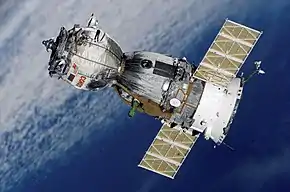Soyuz 20
Soyuz 20 (Russian: Союз 20, Union 20) was an unmanned spacecraft launched by the Soviet Union. It was a long-duration test of the Soyuz spacecraft that docked with the Salyut 4 space station. Soyuz 20 performed comprehensive checking of improved on-board systems of the spacecraft under various flight conditions. It also carried a biological payload. Living organisms were exposed to three months in space.
| Mission type | Test flight |
|---|---|
| Operator | Soviet space program |
| COSPAR ID | 1975-106A |
| SATCAT no. | 08430 |
| Mission duration | 90 days 11 hours 47 minutes |
| Orbits completed | 1470 |
| Spacecraft properties | |
| Spacecraft | Soyuz 7K-T No.8 |
| Spacecraft type | Soyuz 7K-T/A9 |
| Manufacturer | NPO Energia |
| Launch mass | 6570 kg [1] |
| Landing mass | 2800 kg |
| Dimensions | 7.13 m long 2.72 m wide |
| Start of mission | |
| Launch date | 17 November 1975, 14:36:37 UTC |
| Rocket | Soyuz-U |
| Launch site | Baikonur, Site 1/5 [2] |
| End of mission | |
| Landing date | 16 February 1976, 02:24 UTC |
| Landing site | 56 km at the southwest of Arkalyk, Kazakhstan |
| Orbital parameters | |
| Reference system | Geocentric orbit [3] |
| Regime | Low Earth orbit |
| Perigee altitude | 199.7 km |
| Apogee altitude | 263.5 km |
| Inclination | 51.6° |
| Period | 88.8 minutes |
| Docking with Salyut 4 | |
Crew
None.
Mission parameters
Return
It was recovered on 16 February 1976 at 02:24 UTC.[1]
References
- "Display: Soyuz 20 1975-106A". NASA. 14 May 2020. Retrieved 13 October 2020.
 This article incorporates text from this source, which is in the public domain.
This article incorporates text from this source, which is in the public domain. - "Baikonur LC1". Encyclopedia Astronautica. Archived from the original on 15 April 2009. Retrieved 4 March 2009.
- "Trajectory: Soyuz 20 1975-106A". NASA. 14 May 2020. Retrieved 13 October 2020.
 This article incorporates text from this source, which is in the public domain.
This article incorporates text from this source, which is in the public domain.
This article is issued from Wikipedia. The text is licensed under Creative Commons - Attribution - Sharealike. Additional terms may apply for the media files.
